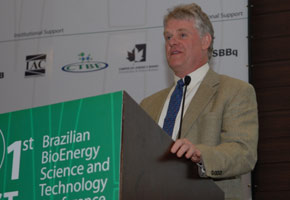

For Lee Lynd of Dartmouth College, Brazil is a good example of how it is possible to combine agricultural production for food and energy (photo:Eduardo Cesar/FAPESP))
For Lee Lynd of Dartmouth College, Brazil is a good example of how it is possible to combine agricultural production for food and energy.
For Lee Lynd of Dartmouth College, Brazil is a good example of how it is possible to combine agricultural production for food and energy.

For Lee Lynd of Dartmouth College, Brazil is a good example of how it is possible to combine agricultural production for food and energy (photo:Eduardo Cesar/FAPESP))
By Janaína Simões
Agência FAPESP – Agricultural production for food and energy is perfectly feasible and compatible, according to Professor Lee Lynd of Dartmouth College, who was one of the speakers at the first Brazilian Bioenergy Science and Technology Conference (BBEST) held August 14-18 in Campos do Jordão (SP).
In his presentation, Lynd also affirmed that liquid biofuels are the best and most sustainable alternative for aviation, maritime and long-haul roadway transportation, if compared to other forms of energy.
According to him, the issue of world hunger is more related to poverty and economic development than bioenergy crops. “After decades of neglect, there is a consensus that the best manner to fight hunger is to help the impoverished and food insecure to cultivate their own food,” he affirms.
Lynd notes that Africa has 12 times more arable land and 30% less people than India, but the Asian country produces enough food to feed its population. The problem facing the African continent is related to organizational and institutional weaknesses, rather than geographic restrictions.
In his opinion, Brazil is a positive example of how it is possible to combine agricultural production for food and energy. Africa is another region with great potential that could replicate the Brazilian experience.
Africa has been the focus of Lynd’s recent research under the auspices of the Global Sustainable Bioenergy Project (GSB), which published an article on food and energy production on that continent in the May edition of Nature magazine.
Created in 2009, GSB is an international project that aims to create incentive for sustainable development of biofuels. In addition to heading up this initiative, the researcher is a partner in Mascoma, a U.S.-based company created in 2005 to research and develop technological pathways for production of cellulosic ethanol.
During BBEST, Lynd presented a proposal that would allow for an increase in biofuel production without impacting the agricultural area dedicated to food. He highlighted recently published international studies that identify areas on every continent where grazing activity could be stepped up.
“Degraded or abandoned pasture areas can be also be utilized, and even food and energy crops such as corn or soybean in the United States can be combined with ryegrass—used for fodder, but which has high biofuel potential—,” he affirmed.
“Another route would be to change the rations used in the livestock sector. There is also the option of planting raw materials for bioenergy in regions where there are not crops for food,” he noted.
BBEST was sponsored by FAPESP, BIOEN-FAPESP, CNPq, Capes, CTBE, UNICA, Braskem, Embraer, BP Biofuels Brazil, Monsanto and Oxiteno.
Republish
The Agency FAPESP licenses news via Creative Commons (CC-BY-NC-ND) so that they can be republished free of charge and in a simple way by other digital or printed vehicles. Agência FAPESP must be credited as the source of the content being republished and the name of the reporter (if any) must be attributed. Using the HMTL button below allows compliance with these rules, detailed in Digital Republishing Policy FAPESP.





